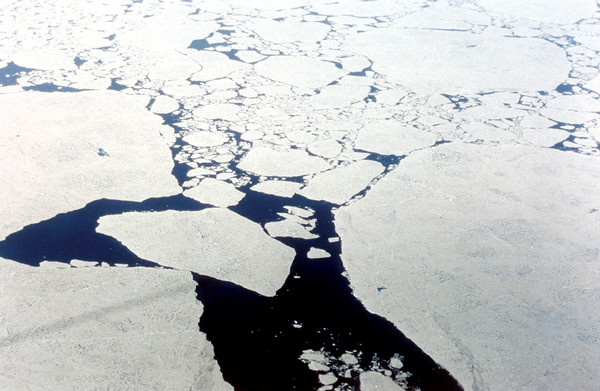
by Jessica Orwig Monday, October 6, 2014

A new 35-year-long look at the extent of Arctic sea-ice seasons indicates that shortening sea-ice seasons are a consequence of Arctic warming. Credit: Claire Parkinson.
Nowhere is climatic warming more evident than in the Arctic. Arctic air has warmed almost twice as much compared to the global average in recent decades, and Arctic sea-ice extent has hit historic lows in the last decade.
Such changes are closely linked with the length of the sea-ice season — the number of days each year when water is frozen, blanketing the Arctic Ocean’s surface. But the concern is about more than just the Arctic Ocean itself, a large portion of which is still capped year-round by ice. Scientists are seeing changes in seas throughout the Arctic, where there is seasonal ice coverage. Now, a recent study offers a 35-year look at the extent to which Arctic sea-ice seasons have changed, and the results support the notion that shortening sea-ice seasons are a consequence of Arctic warming.
Claire Parkinson, a senior scientist at NASA’s Goddard Space Flight Center in Maryland, has been tracking changes in the Arctic since 1978. For this study, published in Geophysical Research Letters, she relied on multiple satellite instruments. Because ice is distinct from water when observed at microwave wavelengths, Parkinson could distinguish whether each pixel in the satellite data represented ice or water. From there, she determined the length of the sea-ice season for each pixel every year from 1979 through 2013, and mapped the results for the Arctic as a whole.
Parkinson found that, on average, the Arctic sea-ice season has decreased by five days each decade. Moreover, the area over which this occurs continues to grow. Before 1988, there were more regions of the Arctic Ocean that had steady sea-ice seasons; then the number of regions with steady sea ice began decreasing. By 2013, the area of ocean with sea-ice seasons that had decreased, on average, five days per decade was double the size it was before 1988.
The data also showed that the sea-ice season in the northern Barents Sea, located north of Norway and Russia, has been decreasing faster than anywhere else in the Arctic. Between 1979 and 2013, the Barents Sea lost, on average, 65 days of ice coverage per decade. That means about 227 fewer days of ice cover in 2013 compared with 1979, Parkinson says.
Meanwhile, the Bering Sea, the stretch of water separating Siberia from Alaska, is one of the few regions where the duration of ice coverage has increased — growing by five to 15 days per decade since 1979. Areas like this, however, now make up less than 10 percent of the sea area in the Arctic Ocean, Parkinson says.
“The very fact that the ice season is getting shorter encourages more warming because it means more of the sun’s radiation that comes down into the Arctic is going into the ocean instead of reflecting off the ice,” she says.
Although melting sea ice will not substantially increase sea levels, for the same reason a melting ice cube in a big glass of water doesn’t raise the water level appreciably, these changes do have consequences.
“Some groups are winners and some groups are losers in this sea-ice decline story,” says Uma Bhatt, an atmospheric scientist at the University of Alaska at Fairbanks, who was not involved with the study. For example, because of the declining ice season, plant species can move in from lower latitudes. That’s good for them, she says, but bad for species of the high Arctic tundra closely tied to sea ice like Papaver polaris, a flower that lives at high latitudes and only survives in very cool temperatures.
“[Parkinson] is adding to the evidence of what we’ve seen already in terms of sea-ice decline,” Bhatt says. “And she looked at it in a slightly different way, which gives us more confidence in our results.”
© 2008-2021. All rights reserved. Any copying, redistribution or retransmission of any of the contents of this service without the expressed written permission of the American Geosciences Institute is expressly prohibited. Click here for all copyright requests.